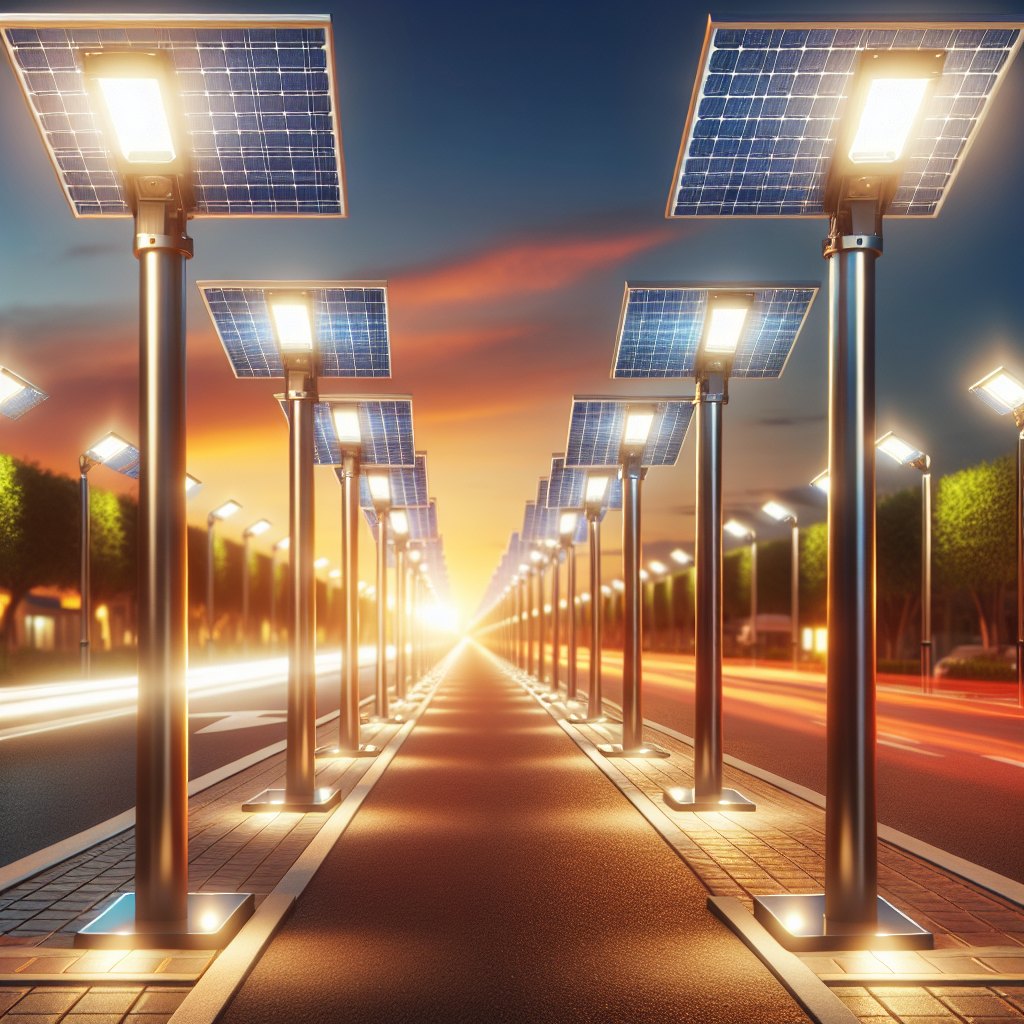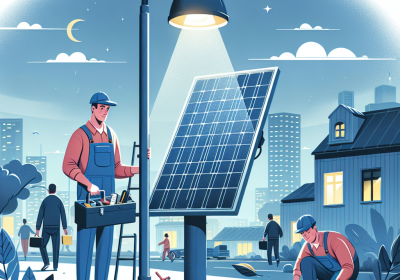Aesthetic Advantages of Commercial Solar Street Lighting
Table of Contents
In recent years, the integration of solar technology into urban infrastructure has gained significant momentum, with commercial solar street lighting emerging as a prominent example. Beyond its functional benefits, such as energy efficiency and sustainability, solar street lighting offers a range of aesthetic advantages that enhance the visual appeal of urban landscapes. These systems are designed to blend seamlessly with various architectural styles, providing a modern and sleek appearance that complements both contemporary and traditional settings. The absence of extensive wiring and the flexibility in design allow for creative placement and arrangement, enabling urban planners to illuminate public spaces without compromising on aesthetics. Additionally, the use of LED technology in solar street lights offers a variety of color temperatures and intensities, allowing for customized lighting solutions that enhance the ambiance of streetscapes, parks, and commercial areas. As cities continue to prioritize both functionality and visual appeal, the aesthetic advantages of commercial solar street lighting play a crucial role in shaping the urban environments of the future.
Enhancing Urban Landscapes: The Visual Appeal of Solar Street Lighting
The integration of solar street lighting into urban landscapes offers a multitude of aesthetic advantages that extend beyond their primary function of illumination. As cities strive to become more sustainable and environmentally friendly, the visual appeal of solar street lighting has emerged as a significant factor in urban planning and design. These lighting solutions not only contribute to reducing carbon footprints but also enhance the visual character of urban environments, creating spaces that are both functional and pleasing to the eye.
One of the most notable aesthetic benefits of solar street lighting is its ability to blend seamlessly with various architectural styles and urban settings. Unlike traditional streetlights, which often require extensive wiring and infrastructure, solar street lights are self-contained units. This independence from the grid allows for greater flexibility in design and placement, enabling urban planners to position them in ways that complement the surrounding architecture and landscape. Consequently, solar street lights can be strategically placed to highlight architectural features, public art, or natural elements, thereby enhancing the overall visual experience of the area.
Moreover, the sleek and modern design of many solar street lighting systems adds a contemporary touch to urban landscapes. With advancements in technology, these lights are available in a variety of styles and finishes, allowing them to be customized to suit the aesthetic needs of different environments. Whether in a bustling city center or a quiet residential neighborhood, solar street lights can be tailored to enhance the unique character of each location. This adaptability not only improves the visual appeal of urban spaces but also fosters a sense of identity and community pride.
In addition to their design versatility, solar street lights contribute to the aesthetic quality of urban landscapes through their environmentally friendly nature. The use of renewable energy sources such as solar power is increasingly associated with modernity and progress. By incorporating solar street lighting, cities can project an image of innovation and sustainability, which can be particularly appealing to residents and visitors alike. This perception is further reinforced by the reduction in light pollution that solar street lights can offer. Many systems are equipped with advanced technology that allows for precise control of light distribution, minimizing glare and ensuring that light is directed only where it is needed. This not only enhances visibility and safety but also preserves the night sky, allowing urban dwellers to enjoy a clearer view of the stars.
Furthermore, the aesthetic advantages of solar street lighting extend to their role in promoting social interaction and community engagement. Well-lit public spaces are more inviting and can encourage people to spend time outdoors, fostering a sense of community and enhancing the vibrancy of urban life. By creating safe and attractive environments, solar street lights can transform previously underutilized areas into lively public spaces, contributing to the social and cultural fabric of the city.
In conclusion, the aesthetic advantages of commercial solar street lighting are manifold, offering a harmonious blend of functionality and visual appeal. As cities continue to evolve and prioritize sustainability, the integration of solar street lighting into urban landscapes will undoubtedly play a crucial role in shaping the future of urban design. By enhancing the visual character of urban environments, these lighting solutions not only illuminate our streets but also illuminate the path toward a more sustainable and aesthetically pleasing future.
Sustainable Design: Merging Functionality with Aesthetic in Solar Lighting

In the realm of sustainable design, the integration of functionality with aesthetic appeal is a crucial consideration, particularly in the development of commercial solar street lighting. As urban landscapes evolve, the demand for energy-efficient solutions that do not compromise on visual appeal has become increasingly significant. Solar street lighting, with its myriad of benefits, stands at the forefront of this movement, offering not only environmental advantages but also a unique aesthetic that enhances urban and suburban environments alike.
To begin with, the aesthetic advantages of commercial solar street lighting are evident in its sleek and modern design. Unlike traditional street lighting, which often relies on bulky infrastructure and extensive wiring, solar street lights are designed to be self-sufficient and streamlined. This minimalist approach not only reduces visual clutter but also allows for greater flexibility in design. Architects and urban planners can incorporate these lights into a variety of settings, from bustling city centers to serene park pathways, without disrupting the existing landscape. The unobtrusive nature of solar street lighting ensures that it complements rather than competes with its surroundings, creating a harmonious blend of technology and nature.
Moreover, the versatility of solar street lighting extends beyond its physical design. The technology allows for a range of customization options, enabling designers to tailor the lighting to specific aesthetic and functional needs. For instance, the color temperature of the LED lights can be adjusted to create different atmospheres, from warm, inviting glows to cool, crisp illumination. This adaptability ensures that the lighting can enhance the desired ambiance of a space, whether it be a lively public square or a tranquil residential street. Additionally, the integration of smart technology allows for dynamic lighting solutions, such as dimming capabilities and motion sensors, which not only conserve energy but also add an element of sophistication to the lighting design.
Transitioning from the design aspects, it is important to consider the environmental benefits that contribute to the overall appeal of solar street lighting. By harnessing renewable energy from the sun, these lights significantly reduce carbon emissions and reliance on fossil fuels. This sustainable approach aligns with the growing global emphasis on environmental responsibility and climate action. Communities that adopt solar street lighting not only benefit from reduced energy costs but also gain a reputation for being forward-thinking and environmentally conscious. This positive image can enhance the aesthetic value of a community, attracting residents and businesses who prioritize sustainability.
Furthermore, the durability and low maintenance requirements of solar street lighting add to its aesthetic appeal. Traditional lighting systems often require frequent maintenance and replacement, leading to disruptions and unsightly construction zones. In contrast, solar street lights are designed to withstand harsh weather conditions and have a longer lifespan, reducing the need for constant upkeep. This reliability ensures that the visual integrity of a space is maintained over time, contributing to a consistently pleasing environment.
In conclusion, the aesthetic advantages of commercial solar street lighting are multifaceted, encompassing design flexibility, environmental benefits, and long-term reliability. As cities and communities continue to seek sustainable solutions that do not compromise on visual appeal, solar street lighting emerges as a leading choice. By merging functionality with aesthetic considerations, this innovative technology not only illuminates spaces but also enhances the overall quality and character of urban and suburban landscapes.
Illuminating Public Spaces: The Artistic Impact of Solar Street Lights
The integration of solar street lighting into urban landscapes has not only revolutionized energy consumption but also transformed the aesthetic appeal of public spaces. As cities strive to become more sustainable, the adoption of solar street lights has emerged as a pivotal element in urban planning. These lights, powered by renewable energy, offer a unique blend of functionality and artistic expression, enhancing the visual appeal of streetscapes while promoting environmental responsibility.
One of the most significant aesthetic advantages of commercial solar street lighting is its ability to seamlessly blend with various architectural styles. Unlike traditional street lights, which often require extensive wiring and infrastructure, solar street lights are self-contained units. This independence from the grid allows for greater flexibility in design and placement, enabling urban planners to incorporate them into diverse environments without disrupting the existing aesthetic harmony. Consequently, solar street lights can be found illuminating historic districts, modern cityscapes, and suburban neighborhoods alike, each time enhancing the unique character of the area.
Moreover, the design of solar street lights has evolved significantly, with manufacturers offering a wide range of styles and finishes to suit different aesthetic preferences. From sleek, minimalist designs to ornate, vintage-inspired fixtures, solar street lights can be customized to complement the surrounding architecture and landscape. This versatility not only enhances the visual appeal of public spaces but also allows cities to maintain a cohesive aesthetic identity, even as they adopt cutting-edge technology.
In addition to their design flexibility, solar street lights contribute to the artistic impact of public spaces through their innovative use of light. The quality of light emitted by solar street lights is often superior to that of traditional lighting solutions, providing a clearer, more natural illumination that enhances the visibility and safety of public areas. Furthermore, advancements in LED technology have enabled solar street lights to offer a range of color temperatures and intensities, allowing for creative lighting schemes that can highlight architectural features, create mood, and enhance the overall ambiance of a space.
The environmental benefits of solar street lighting also play a crucial role in their aesthetic appeal. By harnessing the power of the sun, these lights reduce the carbon footprint of urban areas, contributing to cleaner air and a healthier environment. This commitment to sustainability is increasingly valued by communities and can enhance the perception of a city as forward-thinking and environmentally conscious. As a result, the presence of solar street lights can elevate the image of a public space, making it more attractive to residents and visitors alike.
Furthermore, the use of solar street lighting can inspire artistic and cultural initiatives within public spaces. For instance, cities can organize light festivals or art installations that incorporate solar-powered lights, creating dynamic and engaging experiences for the community. These events not only showcase the versatility and beauty of solar lighting but also foster a sense of community pride and engagement.
In conclusion, the aesthetic advantages of commercial solar street lighting extend far beyond their functional purpose. By offering design flexibility, superior light quality, and environmental benefits, these lights enhance the visual appeal of public spaces while promoting sustainability. As cities continue to embrace renewable energy solutions, solar street lighting will undoubtedly play an increasingly important role in shaping the artistic and cultural landscape of urban environments.
Read more about Solar Street Lighting:









